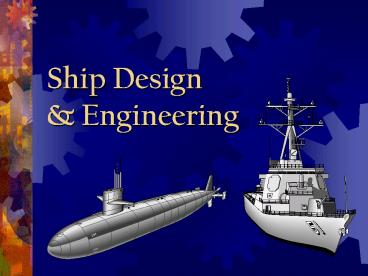Ship Design - PowerPoint PPT Presentation
1 / 25
Title:
Ship Design
Description:
Mission: task or job ship is designed to perform. Armament: measure of offensive & defensive power of ship ... Structural design & seaworthiness ... – PowerPoint PPT presentation
Number of Views:295
Avg rating:3.0/5.0
Title: Ship Design
1
Ship Design Engineering
2
Introduction
- Principles of ship design
- Basic ship structure, including forces
- Ship structural elements
- Compartment Numbering
- Submarine Design
- Piping Systems Coloring
3
Basic Design Considerations
- Operation Employment
- Mission task or job ship is designed to perform
- Armament measure of offensive defensive power
of ship - Protection features designed to thwart or
minimize destructiveness of enemy attack - Maneuverability rapid course/speed changes
- Cruising range distance a ship can travel at
cruising speed without refuel/reprovision
4
Basic Design Considerations
- Structural design seaworthiness
- Stability ability of ship to return to an
upright position when heeled over - Displacement measured in tons of water
- Freeboard vertical distance between top of hull
and water line - Hull shape
- Beam
5
Basic Forces Acting on Ships
- Stress
- Load per unit area (psi)
- Tension, compression, shear, torsion
- Strain
- Deformation per unit length
- Longitudinal Bending
- Sagging
- Hogging
6
Stress
- Defn load a member is carrying per unit area
(psi)
- Types
- Tension axial stress exerted by pulling
- Compression axial stress exerted by pressure on
ends - Shear equal but opposite forces at right angle
- Torsion stress caused by twisting motion
7
Strain
- Defn the distortion/deformation per unit length
as a result of stress - Measured in inches per inch (in/in)
8
Sagging
- Condition where ship is supported more at its
ends - Compression of main deck
- Tension of the bottom/keel
9
Hogging
- Condition where ship is supported more in its
middle - Tension of main deck
- Compression of bottom/keel
10
Ship Structural Elements
- Keel
- Centerline backbone of ship
- Runs the length of the ship
- Framing
- Ribs of ship, provide structural strength -gt
define form of ship - Types
- Transverse (extend outward from keel)
- Longitudinal (parallel to keel, run length of
ship)
11
Ship Structural Elements
- Bottom
- Cellular region comprised of keel framing
- Plating
- Skin over framework -gt rectangular steel plates
welded together
12
Ship Structural Elements
- Decks
- Floors of a ship (sometimes called levels)
- Horizontal partitions that form tiers
- Main deck is uppermost complete deck
- Bulkhead
- Walls of a ship
- Horizontal partitions that form compartments
- Can either be structural or non-structural
(joiner)
13
Ship Structural Elements
14
Ship Structural Elements
- Doors
- Passage between spaces on SAME level
- Can be Water-Tight (sealed with dogs)
- Individually acting v. Quick-acting
- Hatches
- Passage between spaces on DIFFERENT levels
- Most are water-tight boundaries
15
Compartment Numbering
- System used for ships built after 1949
- 4 main parts
- Deck
- Frame
- Compartment
- Use
ex 5 32 0 E Deck Frame Compartment Use
16
Compartment Numbering
- Deck
- Meaning Space is located on this deck
- Upper levels are 01,02 successively from main
- Main deck is 1
- Lower decks are 2,3,4 successively from main
17
Compartment Numbering
- Frame
- Meaning Forward boundary of compartment is on
or immediately aft of this frame number - Sequential number given to transverse frames fore
to aft
18
Compartment Numbering
- Compartment
- Indicates position of compartment relative to
centerline - Centerline compartments are 0
- Numbers follow in succession from centerline
outboard - Even numbers for Port side (2,4,6, )
- Odd numbers for Starboard side (1,3,5, )
6 4 2 0 1 3 5
Port Centerline Starboard
19
Compartment Numbering
- Use
- Letter that designates primary use of the space
- Examples
- A Supply Storage
- C Control (ship control or fire control)
- E Engineering
- F Fuel tank
- L Living
- M Ammunition
- T Trunk
- V Void
- W Water tank
20
Submarine Design
- Hull (made of HY-80 or HY-90 steel)
- Watertight envelope designed to resist
submergence pressure at CRUSH DEPTH - Inner hull (pressure hull)
- Outer hull (non-pressure hull)
21
Pressure Hull
- Single hull design
- US submarines
- Quieter
- Larger interior volume
- Double hull design
- Russian submarines
- Easier to manufacture
- Ability to absorb damage
22
Submarine Design
- Structural Members
- Similar to surface ship but rounded for submarine
hull shape and THICKER - All levels have expansion joints (varying
submergence pressures)
23
Submarine Appendages
- Plane surfaces
- Fairwater
- Bow
- Stern
- Rudder
- Sail and superstructure
- Free-flood area
24
Material Selection
- Cost
- Weight
- Durability
- Steel normally used because of strength
- Aluminum and other alloys for corrosion
resistance - Ease of manufacturing
25
Piping Valve Numbering Systems
- White
- Yellow
- Purple
- Dark Gray
- Light Gray/Tan
- Blue
- Light Blue
- Orange
- Steam
- Oil
- JP-5
- HP Air
- LP Air
- Chillwater
- Feedwater
- Hydraulics
- Numbering system for valves similar to that for
compartments (ie MS-1, MS-2, etc.)
26
Questions, Comments, Concerns?































